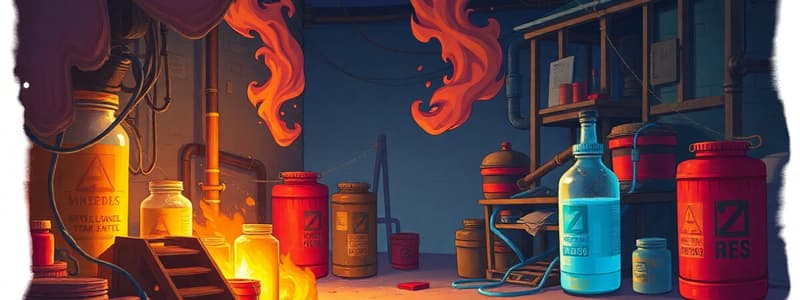Podcast
Questions and Answers
Where are the MSDS located at Murdoch?
Where are the MSDS located at Murdoch?
- Biology Lab, Chemistry Lab, Science Lab Prep Room, and Vocational Areas
- Biology Lab, Chemistry Lab, Science Lab Prep Room, Industrial Arts Areas, and Art Room (correct)
- Biology Lab, Chemistry Lab, Science Lab Prep Room, Industrial Arts Areas, and Art Room (correct)
- Only in the Biology Lab and Chemistry Lab
Workers (students and teachers) at Murdoch are trained and then re-trained in WHMIS every other year.
Workers (students and teachers) at Murdoch are trained and then re-trained in WHMIS every other year.
False (B)
What are the four ways chemicals can enter the body?
What are the four ways chemicals can enter the body?
Ingestion, inhalation, absorption, and through the eyes.
A worker would use an MSDS sheet to look up information on ______, how to handle the product, needed first aid information, and wanted to know the hazards associated with the product.
A worker would use an MSDS sheet to look up information on ______, how to handle the product, needed first aid information, and wanted to know the hazards associated with the product.
Match the following ways chemicals can enter the body with their corresponding descriptions:
Match the following ways chemicals can enter the body with their corresponding descriptions:
What does WHMIS stand for?
What does WHMIS stand for?
Which of the following is NOT a characteristic of Class F - Reactive Materials?
Which of the following is NOT a characteristic of Class F - Reactive Materials?
The Supplier Label must include a reference to the MSDS.
The Supplier Label must include a reference to the MSDS.
WHMIS was implemented to inform only workers about hazardous materials.
WHMIS was implemented to inform only workers about hazardous materials.
What is the significance of the number 4 in the diamond hazard rating system used on workplace labels?
What is the significance of the number 4 in the diamond hazard rating system used on workplace labels?
What are the three parts of WHMIS?
What are the three parts of WHMIS?
Class B controlled products include ______ and ______ materials.
Class B controlled products include ______ and ______ materials.
The ______ provides specific information on a controlled product, including its hazards, safe handling procedures, and emergency protocols.
The ______ provides specific information on a controlled product, including its hazards, safe handling procedures, and emergency protocols.
Match the following types of labels to their corresponding descriptions:
Match the following types of labels to their corresponding descriptions:
Match the following WHMIS classes with their corresponding categories:
Match the following WHMIS classes with their corresponding categories:
Which of the following is NOT a division of Class D controlled products?
Which of the following is NOT a division of Class D controlled products?
Which of the following substances is NOT controlled under WHMIS?
Which of the following substances is NOT controlled under WHMIS?
An MSDS must be less than 10 years old.
An MSDS must be less than 10 years old.
Compressed gas can be explosive because they are under pressure.
Compressed gas can be explosive because they are under pressure.
What does MSDS stand for?
What does MSDS stand for?
Explain why Class D3 controlled products are often found in hospitals.
Explain why Class D3 controlled products are often found in hospitals.
Flashcards
WHMIS
WHMIS
Workplace Hazardous Material Information System, a Canadian standard for hazard communication.
Parts of WHMIS
Parts of WHMIS
WHMIS consists of a labeling system, MSDS, and worker training programs.
Class A Product
Class A Product
Compressed Gas, which can be explosive and under pressure.
Class B Product
Class B Product
Signup and view all the flashcards
Class C Product
Class C Product
Signup and view all the flashcards
Class D1 Product
Class D1 Product
Signup and view all the flashcards
Class D2 Product
Class D2 Product
Signup and view all the flashcards
Class D3 Product
Class D3 Product
Signup and view all the flashcards
MSDS
MSDS
Signup and view all the flashcards
Ways chemicals enter the body
Ways chemicals enter the body
Signup and view all the flashcards
Preventative Measures
Preventative Measures
Signup and view all the flashcards
First Aid Measures
First Aid Measures
Signup and view all the flashcards
Biohazardous Materials
Biohazardous Materials
Signup and view all the flashcards
Corrosive Materials
Corrosive Materials
Signup and view all the flashcards
Reactive Materials
Reactive Materials
Signup and view all the flashcards
Supplier Label
Supplier Label
Signup and view all the flashcards
Workplace Label
Workplace Label
Signup and view all the flashcards
Labeling System
Labeling System
Signup and view all the flashcards
Study Notes
WHMIS Overview
- WHMIS stands for Workplace Hazardous Material Information System
- Implemented to inform workers and employers about hazardous materials in the workplace
- Consists of three parts: labeling system, Material Safety Data Sheets (MSDS), and worker training programs
- Controlled products, or products that can be hazardous, are covered under WHMIS
Classes of Controlled Products
-
Eight classes of controlled products
-
Class A: Compressed Gas
- Gases under pressure can be extremely dangerous because they are explosive
-
Class B: Flammable and Combustible Materials
- Flammable means able to be burned with a source
- Combustible means able to burst into flames without a source.
-
Class C: Oxidizing Materials
- Materials that burn in the presence of oxygen; more oxygen = better/longer burn
-
Class D1: Poisonous and Infectious Materials - Immediate and Serious Toxic Effects
- Materials causing immediate and serious toxic effects
- Can include rapid injury or even death
-
Class D2: Poisonous and Infectious Materials - Other Toxic Effects
- Materials causing other toxic effects
- Side effects include irritation or cancer
-
Class D3: Biohazardous and Infectious Materials
- Biological/organic materials that can be harmful
- Examples include human waste and blood. Commonly seen in hospitals
-
Class E: Corrosive Materials
- Hazardous because it damages skin and can eat through metals
- Difficult to contain
-
Class F: Dangerously Reactive Materials
- Extremely dangerous, some materials can explode from simple shaking or exposure to certain temperatures.
Items Not Covered Under WHMIS
- Items controlled by other government Acts, such as explosives, cosmetics, drugs (medications), food, pest control products, nuclear substances, wood, manufactured articles, tobacco, and goods handled and transported under the Transportation of Dangerous Goods Act.
Supplier Labels
- Provided by supplier.
- Includes product identifier, hazard symbol, risk phrases, precautionary statements, first-aid measures, supplier identification, and a reference to the MSDS.
- Attached to the container that the controlled product arrives in and is stored in
Workplace Labels
- Affixed to containers used in the preparation of chemicals.
- Most commonly seen by students
- Includes product identifier, safe handling information (including PPE), and references to MSDS
MSDS (Material Safety Data Sheets)
-
Technical bulletins containing hazard information, safe handling information, and emergency procedures for controlled products.
-
Provided by suppliers
-
Should be less than 3 years old
-
Include:
-
Product information
-
Hazardous ingredients
-
Physical data
-
Fire and explosion hazards
-
Reactivity hazards
-
Toxicological properties
-
Preventive measures
-
First-aid measures
-
MSDS preparation information
-
Locations of MSDS at Murdoch are: Biology Lab, Chemistry Lab, Science Lab Prep Room, Vocational Areas, Industrial Arts Areas, and Art Room
Worker Training
- Workers (students and teachers) must be trained and re-trained in WHMIS yearly.
- Worker responsibilities include understanding WHMIS labels, symbols, classification of controlled products, and MSDS, storage of chemicals, and safe handling (including PPE) of each controlled product used
- Students must pass a quiz on the presentation material at 80% before performing labs containing controlled products
Additional Information
- Ways controlled products can enter the body: Ingestion, Inhalation, Absorption through the skin, and through eyes
Studying That Suits You
Use AI to generate personalized quizzes and flashcards to suit your learning preferences.




